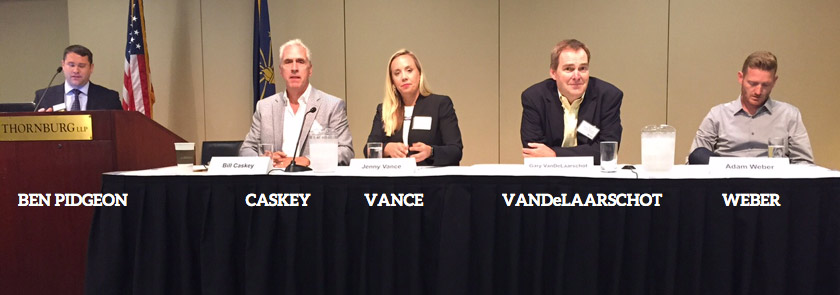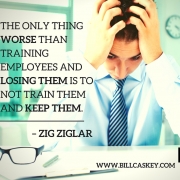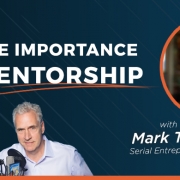Is The Selling Profession Nearing Its End?
This was a question posed at a recent panel discussion I was on. It was to a group of small business owners. I’m usually not a big fan of panel discussions due to the limited time each participant has to speak.

But this one was good…Ben Pidgeon, Barnes & Thornburg LLP, facilitated the event and we had awesome panelists: Jenny Vance (www.leadjen.com), Gary VanDeLaarschot (www.accelerate.com) and Adam Weber (www.GoBlueBridge.com).
Here’s my answer to the question of whether the salesperson is going away.
No….but.
No, the sales function is NOT going away anytime soon. But, the fact is that selling is changing. Here are my thoughts on how it’s changing and what you can do to cope, whether you’re a sales team leader or front-line seller.
1. Seller Must Offer Insight. You are not an order taker or an order maker. Most of the time, the customer has no earthly idea if they are in need of your solution or not. So, you must offer some form of “insight” to help guide the prospect along. That may be a case study, it may be a list of the trends you see impacting your clients, or it may be an article that you have published that positions you as an expert AND offers value. Don’t just run the prospect through your process. They deserve more than that.
2. A Supreme Diagnoser. A part of the new role of a seller is a diagnoser of what’s wrong. You are in the role of building “dissonance.” Dissonance is described as the gap between where someone is and where they want to be. If you can’t uncover dissonance with your prospect, then their best decision may be no decision. You do this through the diagnostic portion of the process. You NEVER sell during this portion. If you do, all of your relationship capital is spent. Understand what their world is like now WITHOUT your product. And what it could be WITH your solution. That is where dissonance lies.
[shareable text=”Dissonance- the gap between where someone is and where they want to be. “]Dissonance- the gap between where someone is and where they want to be. If you can’t uncover dissonance with your prospect, then their best decision may be no decision.[/shareable]
3. A Process Guide. You are a guide that shepherds the prospect down the path from Awareness to Comprehension to Conviction to Action. No short cuts. If at any point during this process, you attempt to “pitch” your goodies, you’ll be labeled an amateur – no sale. You must know how to maneuver through the buying organization by having a process that is in THEIR best interest, not yours. And you must be adept at laying it out, so they know exactly what is expected of them. It’s hard to suggest they follow your process if you don’t have one they can believe in!
4. A Cause Bigger Than The Sale. You must have a cause that is larger than making the sale and you must be able to tell that story to the prospect. People want to be a part of a larger story. What is your story? What is the company story? And once you tell it, is it compelling enough for people to want to be part of it? Or, does it sound like every other sales person who’s called on them in the last 30 days?
Granted, there are many other changes, some strategic, some tactical. But these four areas are critical to creating a sales team that performs at a high level.
What do you think? What are some of the changes you see in the art and craft of selling? What does the future hold? Let me know in the comments below.









Hi Bill,
Interesting concept you bring up with dissonance. Thanks.
Sure Buyers buy differently than ever before so Sellers need to adapt and bring all what you advise here and I agree 100%. Especially #4: I think that this is what you need to bring out to keep your client on the long run. If you share same core values and culture (linked to the bigger cause), then trust can only flurish overtime.
Now, I experience a very tough point with a number of customers nowadays and observed it at a number of occasions: They commit nearly all the way (master agreements sent to us to be signed off and never return them signed…). Or they show interest, call on for more information, more advanced calls and then vanish (stop answering …).
So fine, we can always think: ok leave the situation as it is and wait until they are ready again (In all cases, operations were in need and ready to help finalise deals with other internal stakeholders). I believe in abundance like you guys but still, this patern becomes a trend to me.
So to be franck, the craft of selling to me is this ability for us to spot this irrational behaviors as early as possible during the process in order to concentrate more the next one. BUT how can you predict such kinds of irrational behaviors (at least that ‘s how I see them).
I would really like to know if you come accross that kind of feedbacks these days.
Concl: Anticipation seems to be part of the modern art of selling.
PS: I sell recruitment services to large blue chip companies in 3 majors regions (Europe, MENA and SEA)
Look forward to keep on following your coming up contents.
BR
Mathieu
Mathieu, awesome comments! Not sure it’s irrational…sorry, but it might be they don’t see, a) a real pain to be solved, b) a true vision to be accomplished, or c) a path forward. You are the “hero’s guide” on the prospects journey. Anything less, and you’re just a sales person. (And I know better than that.) We have to assume that people ALWAYS do exactly what they believe is in their best interest…nothing more…nothing less. Hate to plug here, but look at Same Game New Rules (book) and it will help you. Thanks for stopping by. -BC
Great reminder. If you don’t have detachment, it’s easy to lose sight of this.
Mike…detachment appears to be the key, doesn’t it? I see the concept in many places now…hopefully I had a little something to do with that. Hope you’re well! -BC